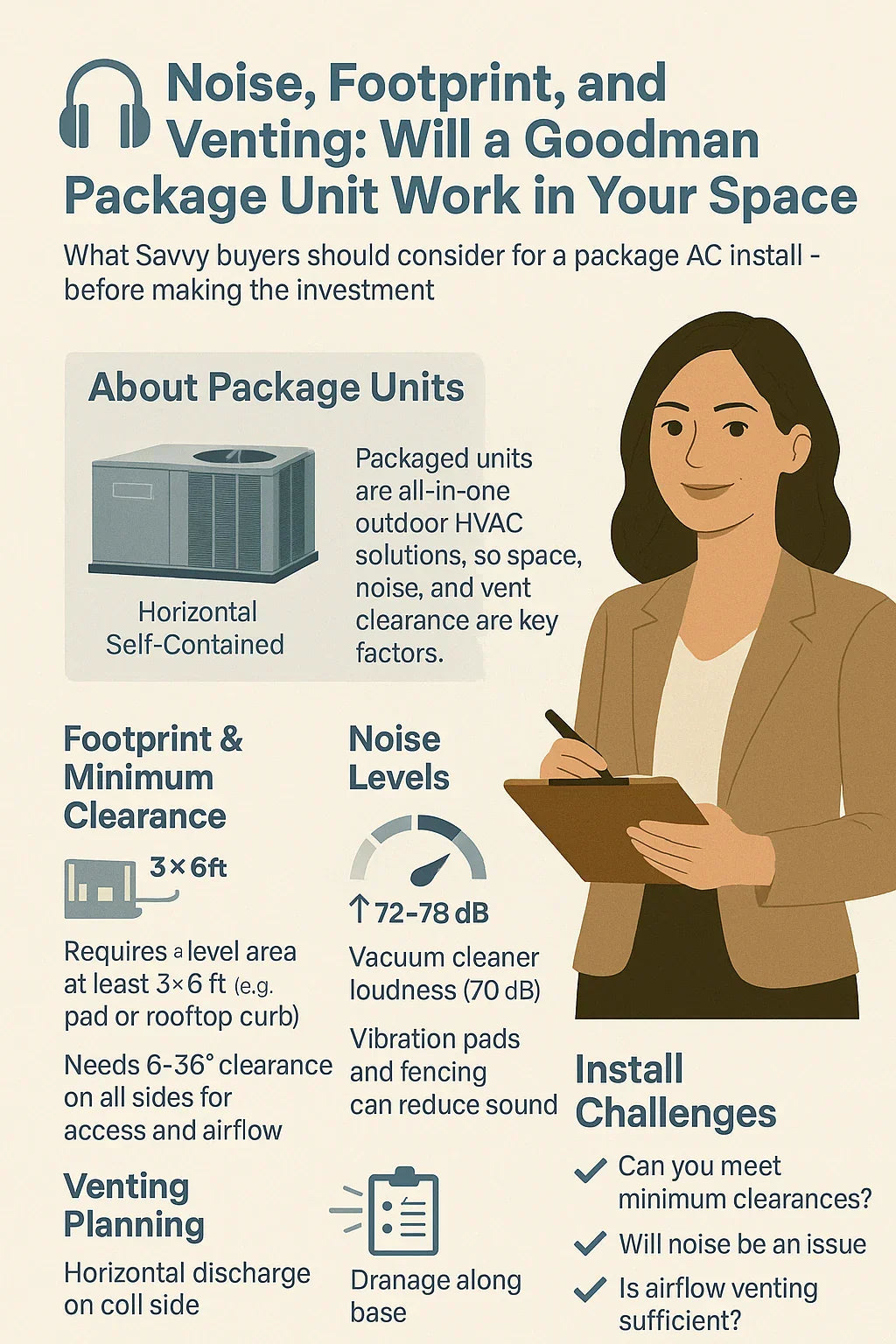Thinking about installing a Goodman 2.5 Ton 13.4 SEER2 Horizontal Package Unit? It’s compact and powerful, but before making the leap, you’ll want to answer one essential question:
Will it fit—physically and practically—in your space?
This guide helps you evaluate unit dimensions, venting paths, clearances, and noise levels to ensure your outdoor installation goes smoothly and works efficiently.
📦 What Is a Packaged Unit and Why Space Matters
A packaged unit houses all its HVAC components (compressor, condenser, coil, blower) in a single cabinet, typically installed outside the home. That makes them:
-
Easier to install (no indoor air handler)
-
Ideal for homes with no attic or basement
-
More dependent on outdoor clearances and airflow
The Goodman unit is designed for ground-level or rooftop installs and vents air side-to-side.
🔗 Manufacturer specs: Goodman Installation Guide
🗺️ How Much Space Does It Need?
| Spec | Goodman 2.5 Ton Horizontal Unit |
|---|---|
| Length | ~51” |
| Width | ~47” |
| Height | ~34” |
✅ Required Clearances:
-
Front (service side): 36” minimum
-
Back: 6” minimum from wall
-
Sides: 24” recommended
-
Above (if vented up): 60” clearance
-
Drain access & disconnect box: within visible reach
⚠ Pro Tip: Place the unit on a pre-leveled concrete pad or curb. Do not install directly on dirt.
🔈 How Loud Is a Horizontal Package Unit?
🎧 Typical Noise Rating:
-
72 to 78 decibels (dB) during cooling mode
-
Louder than a split system condenser
🤔 For comparison:
-
60 dB: normal conversation
-
70 dB: vacuum cleaner
-
80 dB: garbage disposal
🎩 Noise Mitigation Tips:
-
Use rubber vibration pads under the unit
-
Avoid placing near bedrooms or patios
-
Install a fence or wall to deflect noise
-
Use shrubs or acoustic panels to dampen sound (with airflow clearance)
🌬️ Venting & Airflow Direction
This Goodman model uses horizontal discharge:
-
Air enters through side panels
-
Cooled air exits sideways (not upward)
⚠ Airflow Positioning Tips:
-
Keep discharge side away from walls, walkways, or decks
-
Avoid blowing air toward:
-
Windows
-
Neighboring fences
-
Outdoor gathering zones
-
-
Maintain 24–36” of open space on airflow side
❌ Do not obstruct discharge airflow—it reduces efficiency and raises compressor pressure.
🏛️ Common Property Constraints
🏡 Small Yards
-
Check if a 4 ft x 6 ft slab fits with proper airflow
🏥 Rooftop Installs
-
May require crane access
-
Roof must support ~300+ lbs
-
Need wind strapping and curb
🛏️ Mobile Homes
-
May install on skirted HVAC stand
-
Consider crawlspace duct routing
🏠 HOA Rules & Local Codes
-
Noise level limits (esp. < 80 dB)
-
Height/visibility restrictions
-
Pad or rooftop mounting code requirements
🚧 Maintenance Access: Don’t Box It In
HVAC techs need room to service the unit. Plan:
-
36” in front of access panel
-
At least 24” on the coil side
-
Drainage line with fall to grade
-
Visible disconnect switch
⚡ Tip: Avoid fencing it in unless you leave a removable gate or panel.
🏧 Venting the Condensate & Optional Heat
-
Condensate drain must slope away and exit visibly
-
Avoid uphill or kinked drain lines
-
For units with gas heat: must meet vent code clearance from windows, doors, etc.
-
Use UV-rated tubing or PVC drain lines
Reminder: Do not cap vents or cover units with solid tarps
🔢 Savvy Checklist: Will This Fit in Your Space?
| Question | Yes/No |
| Do I have 3’4 feet of level ground or roof space? | ☑ / ❌ |
| Can I provide 24”–36” airflow clearance on all sides? | ☑ / ❌ |
| Is the unit away from windows or neighbor boundaries? | ☑ / ❌ |
| Can I access the drain line and disconnect box easily? | ☑ / ❌ |
| Will it meet noise/code/HOA requirements? | ☑ / ❌ |
🚀 Final Takeaways
-
The Goodman horizontal package unit is a space-saving, efficient option for many homes—but it needs room to breathe.
-
Plan for airflow, noise, and accessibility from the start.
-
Don’t guess—measure.
-
Consult an HVAC professional to ensure code compliance and optimal performance.
In the next topic we will read about: Budget Breakdown: Total Cost to Install a 2.5 Ton Goodman Package AC







